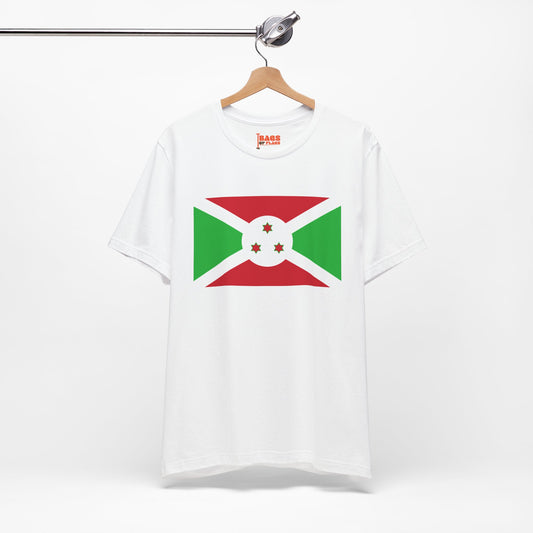-
Burundi Pillow
Regular price $22.65 USDRegular priceUnit price / per -
Burundi Backpack
Regular price $59.79 USDRegular priceUnit price / per -
Burundi Leather Patch Hat
Regular price $18.85 USDRegular priceUnit price / per -
Burundi Flag Sweatshirt
Regular price $34.15 USDRegular priceUnit price / per -
Burundi Sweatshirt
Regular price $34.15 USDRegular priceUnit price / per -
Burundi Mug
Regular price $11.65 USDRegular priceUnit price / per -
Burundi Trucker Cap
Regular price $14.90 USDRegular priceUnit price / per -
Burundi Hoodies
Regular price $34.40 USDRegular priceUnit price / per -
Burundi T-shirts
Regular price $22.79 USDRegular priceUnit price / per -
Burundi Flag on Hoodie
Regular price $34.40 USDRegular priceUnit price / per -
Burundi Flag on T-shirt
Regular price $22.79 USDRegular priceUnit price / per
Collection: Burundi
The Burundi flag symbolizes the East African country's rich history and culture. With its striking design and vibrant colors, the flag of Burundi holds significant meaning for its people. We will delve into the lesser-known facts and display protocols of the Burundi flag.
Overview of the Burundi Flag's Design and Colors

At the heart of the flag's design lies a distinctive white saltire that elegantly segments the banner into four quadrants: two of which are painted in a bold red and the remaining two in a verdant green. Central to the flag's aesthetic is a white disk adorned with three six-pointed stars arranged in a tight triangular configuration. Each color meticulously selected for the flag conveys deep symbolic significance.
The vibrant red symbolizes the country's long struggle for independence, depicting the sacrifices and bloodshed endured by its people. Green offers a hopeful glance towards the land's prosperity and richness, echoing Burundi's agricultural bounty and natural beauty. White acts as a beacon of peace, bridging the vibrant red and green with its purity and serenity and setting the stage for unity and harmony within the nation. This tricolor scheme is not merely decorative but weaves together the foundational values and aspirations of the Burundian people, making the flag a profound emblem of national identity and pride.
Historical Context of the Burundi Flag

Adopted on March 28, 1967, the flag of Burundi was established following the nation's independence from Belgian colonial rule. This period was marked by the country's desire to forge a new national identity separate from its colonial past. The original design has stood the test of time, a testament to the enduring values and aspirations it represents. The introduction of the flag coincided with a critical juncture in Burundi's history as it navigated the challenges of self-governance and sought to unify its diverse population.
The three stars, symbolizing the ethnic groups of Hutu, Tutsi, and Twa, were a deliberate choice to promote unity and represent the collective identity of all Burundians. This choice highlighted the nation's commitment to moving forward as one despite the complex inter-ethnic dynamics that have shaped its history. The adoption of the flag was not just a ceremonial act but a pivotal moment that reflected the hopes and dreams of a country at the dawn of a new era.
Symbolism Embedded in the Burundi Flag
The Burundi flag is imbued with deep symbolism that reflects the nation's values, history, and aspirations. The white saltire not only nods to the country's Christian heritage but also serves as a powerful symbol of peace, acting as a unifier among the Burundian people. It cuts across the flag, symbolically joining the disparate elements into a cohesive whole, representing the desire for national unity and harmony amidst diversity.
The flag's vibrant red panels speak to the struggles and sacrifices made during the fight for independence, a reminder of the bloodshed and bravery that paved the way for the country's sovereignty. This color embodies the resilience and courage of the Burundian people, underscoring their willingness to protect and defend their freedom at all costs.
On the other hand, green signifies the hope for prosperity and the abundance of the land. It highlights Burundi's agricultural roots and the rich natural resources that are a cornerstone of its economy and a source of sustenance for its people. This color symbolizes the potential for growth and renewal, encouraging a forward-looking optimism among the populace.
At the flag's center, the three six-pointed stars represent unity, work, and progress guiding principles. These stars are a commitment to solidarity among Burundi's ethnic groups and a reminder of the collective effort required to build a peaceful and prosperous nation. These symbols weave a rich tapestry of meaning, making the Burundi flag a profound emblem of the country's identity and aspirations.
Current Relevance of the Burundi Flag
Today, the Burundi flag remains a pivotal symbol within the nation, prominently featured during significant national events, military commemorations, and Independence Day festivities, underscoring the country's sovereignty and unity. Its presence extends beyond mere ceremonial use, serving as a constant reminder of the nation's heritage, struggles, and aspirations.
While it is deeply ingrained in the country's identity, the flag has also been at the center of discussions in times of political and ethnic strife. Debates have emerged regarding the flag's symbolism and whether it fully captures the intricate diversity of Burundi's populace. These discussions reflect the evolving nature of national identity and the ongoing dialogue about inclusivity and representation. Despite these debates, the flag continues to be a source of pride for many Burundians, symbolizing hope and resilience as the country navigates its future. Its relevance today speaks to Burundi's enduring strength and unity, even as it confronts challenges and seeks paths toward reconciliation and peace.
Additional Facts and Unique Display Protocols for the Burundi Flag
In adherence to the respect and honor it symbolizes, the Burundi flag must never come into contact with the ground or any objects beneath it, signifying the nation's sovereignty and the dignity of its people. Its display is strictly from dawn until dusk, ensuring it is always visible under appropriate lighting conditions after dark. Protocols dictate that when flown alongside flags of other nations, the Burundi flag takes a prestigious position on the observer’s left, showcasing its independence and equal standing among the international community.
The process of raising the flag is to be done swiftly, reflecting the vigor and resilience of the nation. At the same time, its lowering should occur with a sense of gravity and respect, mirroring the solemn pride of the Burundian people. Additionally, the national anthem's playing during these moments imbues the act with a more profound sense of patriotism and reverence. These protocols not only prescribe how the flag is to be displayed but also encapsulate the profound respect Burundians hold for their national emblem and the values it represents.






















